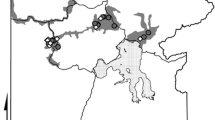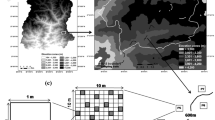Abstract
I examined the winter diets of a reintroduced population of bison (Bison bison) in a mountainous region of northwestern Canada. The impetus of this study was to examine the winter diets of bison in this ecological region and to test for sexual and seasonal variation in the winter diet. Microhistological analyses of fecal samples from animals of known sex- and age-classes were examined to determine winter diets. I evaluated the hypothesis that sexual segregation in bison may be due to differences in diet. In addition, diet composition between early and late winter was examined to test for seasonal differences. Overall, bison winter diets were diverse, including at least 31 genera of vascular plants, but dominated by sedges (Carex). Nine species of Carex were identified in the winter diet. Diets of adult males in early winter differed in percentages of 7 forage classes used from those in late winter. The proportion of shrubs increased in late-winter diets, while that of sedges decreased. No evidence was found to support hypotheses of sexual segregation in bison based on differences in diet, at least for this population during late winter. This study shows that bison diets in winter are more diverse than previously thought based on studies in lowland boreal environments, where dietary niche breadth was comparatively narrow. Dietary flexibility is important within the context of choosing new sites for reintroducing bison, or predicting colonization of vacant habitats as existing populations grow.

Similar content being viewed by others
References
Bowyer RT (2004) Sexual segregation in ruminants: definitions, hypotheses, and implications for conservation and management. J Mammal 85:1039–1052
Campbell BH, Hinkes M (1983) Winter diets and habitat use of Alaskan bison after wildfire. Wildl Soc Bull 11:16–21
Courant S, Fortin D (2012) Search efficiency of free-ranging plains bison for optimal food items. Anim Behav 84:1039–1049
Dearden BL, Pegau RE, Hansen RM (1975) Precision of microhistological estimates of ruminant food habits. J Wildl Manage 39:402–407
Fischer LA, Gates CC (2005) Competition potential between sympatric woodland caribou and wood bison in southwestern Yukon, Canada. Can J Zool 83:1162–1173
Fortin D, Fryxell JM, Pilote R (2002) The temporal scale of foraging decisions in bison. Ecol 83:970–982
Government of Yukon (2012) Management plan for the Aishihik wood bison (Bison bison athabascae) population in southwestern Yukon. Government of Yukon, Whitehorse
Hawley AWL, Peden DG, Reynolds HW, Stricklin WR (1981) Bison and cattle digestion of forages from the Slave River Lowlands, Northwest Territories, Canada. J Range Manage 34:126–130
Hernández L, Laundré JW (2005) Foraging in the ‘landscape of fear’ and its implications for habitat use and diet quality of elk, Cervus elaphus, and bison, Bison bison. Wildl Biol 11:215–220
Hoffman RR (1989) Evolutionary steps of ecophysiological adaptation and diversification of ruminants: a comparative view of their digestive system. Oecol 78:443–457
Holechek JL, Valdez R (1985) Magnification and shrub stemmy material influences on fecal analysis accuracy. J Range Manage 38:350–352
Jung TS, Stotyn SA, Czetwertynski SM (2015) Dietary overlap and potential competition in a dynamic ungulate community in northwestern Canada. J Wildl Manage 79. doi:10.1002/jwmg.946
Kagima B, Fairbanks WS (2013) Habitat selection and diet composition of reintroduced native ungulates in a fire-managed tallgrass prairie reconstruction. Ecol Restor 31:79–88
Krebs CJ (1999) Ecological methodology, 2nd edn. Benjamin/Cummings, Menlo Park
Larter NC, Gates CC (1991) Diet and habitat selection of wood bison in relation to seasonal changes in forage quality. Can J Zool 69:2677–2685
Main MB, Weckerly FW, Bleich VC (1996) Sexual segregation in ungulates: new directions for research. J Mamm 77:449–461
Nicholson MC, Bowyer RT, Kie JG (2006) Forage selection by mule deer: does niche breadth increase with population density? J Zool 269:39–49
Post DM, Armbrust TS, Horne EA, Goheen JR (2001) Sexual segregation results in differences in content and quality of bison (Bos bison) diets. J Mammal 82:407–413
Reynolds HW, Hansen RM, Peden DG (1978) Diets of the Slave River Lowland bison herd, Northwest Territories, Canada. J Wildl Manage 42:581–590
Rucksthul KE, Neuhaus P (2000) Sexual segregation in ungulates: a new approach. Behav 137:361–377
Rucksthul KE, Neuhaus P (2002) Sexual segregation in ungulates: a comparative test of three hypotheses. Biol Rev Camb Phil Soc 77:77–96
Sparkes DR, Malechek JC (1968) Estimating percentage dry weights using a microscopic technique. J Range Manage 21:264–265
Telfer ES, Kelsall JP (1984) Adaptation of some large North American mammals for survival in snow. Ecol 65:1828–1834
Todd JW, Hansen RM (1973) Plant fragments in the feces of bighorns as indicators of food habits. J Wildl Manage 37:363–366
Waggoner V, Hinkes M (1986) Summer and fall browse utilization by an Alaskan bison herd. J Wildl Manage 50:322–324
Wolda H (1981) Similarity indices, samples size and diversity. Oecol 50:296–302
Acknowledgments
Microhistological analysis was done by Bruce Davitt at Washington State University. I thank Manfred Hoefs and Philip Merchant for the collection and management of fecal samples and associated data. Funding was provided by the Yukon Department of Environment. Two anonymous reviewers kindly provided comments on an earlier draft of the manuscript.
Author information
Authors and Affiliations
Corresponding author
Additional information
Communicated by: Dries Kuijper
Rights and permissions
About this article
Cite this article
Jung, T.S. Winter diets of reintroduced bison (Bison bison) in northwestern Canada. Mamm Res 60, 385–391 (2015). https://doi.org/10.1007/s13364-015-0240-2
Received:
Accepted:
Published:
Issue Date:
DOI: https://doi.org/10.1007/s13364-015-0240-2




